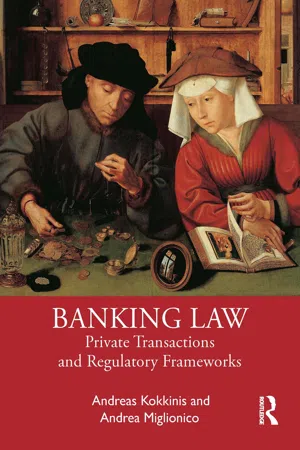
Banking Law
Private Transactions and Regulatory Frameworks
- 448 pages
- English
- ePUB (mobile friendly)
- Available on iOS & Android
About this book
Banking regulation and the private law governing the bank-customer relationship came under the spotlight as a result of the global financial crisis of 2007–2009. More than a decade later UK, EU and international regulatory initiatives have transformed the structure, business practices, financing models and governance of the banking sector. This authoritative text offers an in-depth analysis of modern banking law and regulation, while providing an assessment of its effectiveness and normative underpinnings. Its main focus is on UK law and practice, but where necessary it delves into EU law and institutions, such as the European Banking Union and supervisory role of the European Central Bank. The book also covers the regulation of bank corporate governance and executive remuneration, the promises and perils of FinTech and RegTech, and the impact of Brexit on UK financial services.
Although detailed, the text remains easy to read and reasonably short; pedagogic features such as a glossary of terms and practice questions for each chapter are intended to facilitate learning. It is a useful resource for students and scholars of banking law and regulation, as well as for regulators and other professionals who are interested in reading a precise and evaluative account of this evolving area of law.
Frequently asked questions
- Essential is ideal for learners and professionals who enjoy exploring a wide range of subjects. Access the Essential Library with 800,000+ trusted titles and best-sellers across business, personal growth, and the humanities. Includes unlimited reading time and Standard Read Aloud voice.
- Complete: Perfect for advanced learners and researchers needing full, unrestricted access. Unlock 1.4M+ books across hundreds of subjects, including academic and specialized titles. The Complete Plan also includes advanced features like Premium Read Aloud and Research Assistant.
Please note we cannot support devices running on iOS 13 and Android 7 or earlier. Learn more about using the app.
Information
Part I
Banks and their regulators
1 The banking system
1.1 Introduction
1.2 The historical development of banks and the global financial crisis
Table of contents
- Cover
- Half Title
- Title Page
- Copyright Page
- Table of Contents
- Table of cases
- Table of legislation
- Preface
- Part I Banks and their regulators
- Part II The business of banks
- Part III Preventing banking crises
- Part IV Managing bank failures
- Index